This content is going to need you to tap into your previous knowledge of the nervous system and how we are viewing that as a communication system, transporting information around your body. I gave you the metaphor if the nervous system being like having phone conversations and how neurotransmitters are the message, neurons are the telephone poles bouncing the message cross country, or even continents, to relay the message to the person or place it was aiming for.
So we have messages(Neurotransmitters) being sent, via neurons, from one part of the nervous system to the another and back again. This page is basically shining a magnifying glass on this process and exactly what neurons are and how do they send information from one another.
Here are the definitions that you need to start off knowing:
Neuron: A nerve cells which tranfers information throughout the nervous system
Neurotransmitter: Chemicals which transmit signals from one neuron to the next
For the exam you need to know the following;
- The basic structure of a neuron
- The different types of neurons, how they are structurally different and what their different roles are in the transporting of messages
- Exactly how information passes from one neuron to the next
All of this if covered throughout the rest of this page.
This is a very science heavy part of the spec and requires you to know a lot of key terms, understand them, be able to recall them and them apply that knowledge to unknown situations. The best way to do this is to draw as many diagrams as you can to get your head around it and practise describing and identifying the different key terms and words as often as you can.
Structure of a Neuron
Below is a picture of a basic neuron- this isn’t what all of them look like, but gives you an idea on what it is made up of and how these different parts work together to be successful.
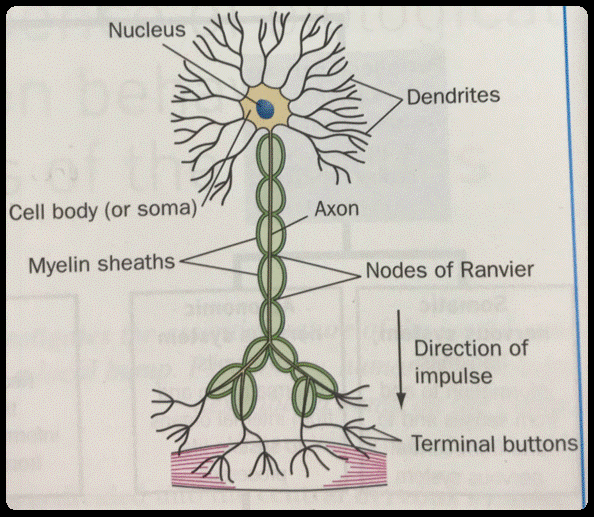
As described in the picture, a neuron is made up of lots of different parts, all of which you need to know. Also the arrow on the right hand side shown the direction in which the electrical impulse carries the message. From top to bottom. At the top of the neuron, the dendrites would be connected to the bottom of another neuron- that neuron’s terminal buttons. Likewise, this neuron’s terminal buttons would connect to the next neurons dendrite and this would continue until it hits muscle or tissue and the message is actioned.
Below is a description of the role of each part of the neuron;
Cell Body (soma): Also known as a soma, the cell body is the neuron’s core. The cell body carries genetic information, maintains the neuron’s structure, and provides energy to drive activities.
Axon: An axon is a long, tail-like structure which joins the cell body at a specialized junction called the axon hillock. Many axons are insulated with a fatty substance called myelin. Myelin helps axons to conduct an electrical signal. Neurons generally have one main axon.
Dendrites: Dendrites are fibrous roots that branch out from the cell body. Like antennae, dendrites receive and process signals from the axons of other neurons. Neurons can have more than one set of dendrites, known as dendritic trees. How many they have generally depends on their role.
Myelin Sheaths: Myelin helps axons to conduct an electrical signal– almost like an insulator to ensure that the the electrical signal doesn’t get lost
Nodes of Ranvier: periodic gap in the insulating sheath (myelin) on the axon of certain neurons that serves to facilitate the rapid conduction of nerve impulses.
Terminal Buttons: the small knobs at the end of an axon that release chemicals called neurotransmitters. The terminal buttons form the Presynaptic Neuron of the synapse.
Sensory Neuron
This tells the rest of the brain about the external and internal environment by processing information taken from 1 of the 5 senses. This is a Unipolar Neuron which means that it only transmits messages in one direction.
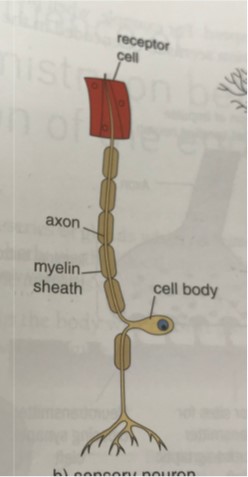
Notice how this neuron doesn’t have dendrites. This is because the end of it is connect to sensory receptors which kick start the whole process. So when your hand touches the hot plate, this is the first neuron to send this information up to your brain.
Motor Neuron
Cell body is located in the spinal cord, the axon projects outside the spinal cord to directly or indirectly control effector organs, mainly muscles and glands. This is based on messages sent from the CNS.
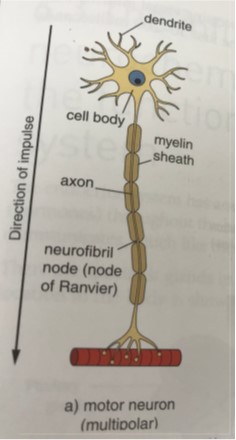
You may have noticed that the terminal buttons are connected to something- this is because its role is activate muscle, glands or organs. Therefore to do this it needs to be connect to that tissue to cause it to move, release of work. similar to the sensory neuron, it is also a unipolar neuron because it’s only role is to send electrical impulses towards the target it needs to activate.
Relay Neuron
These carry messages from one part of the CNS to another. They also connect motor and sensory neurons. These are an example of a multipolar neuron, this is because it needs to send information back and forth between motor and sensory neurons. You will find these in the spinal cord the Brain.
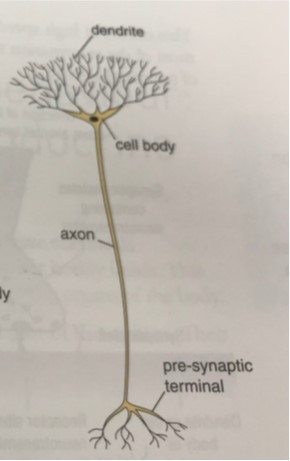
You might have noticed that this is very different from the other two neurons, this is because it is missing the myelin sheaths and nodes of ranvier. The reason for this is because these are already fairly protected by the spinal cord and the brain tissue, therefore the needs to protection isn’t as warranted. Also, the myelin sheaths are there to ensure the message is being passed on but doesn’t necessarily make it faster, whereas the relay neurons do not need to compromise speed to ensure transference, and therefore these would inhibit the message being passed on rather than boost it.
Working Together
Click this link to open a YouTube clip talking you through how they all work together
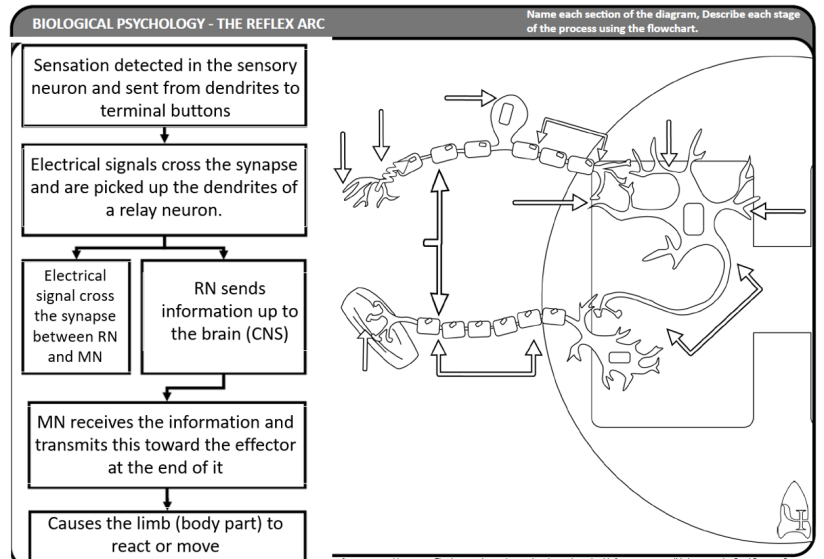
It really important to remember that these are not the only 3 neurons that exist in your body and that this is a really simplified explanations of this. The reason for this is going even more into depth about this is far more than A Level Psychology and is probably more than required of an undergraduate psychology degree. If this is something that you find interesting, it is definitely worth doing some of your own research and maybe reading some books on it, however for the purpose of the course I think it’s wise to stop there so I can ensure you all have a good grasp of the neurons you need to know!
Here is a link to book titles which you might find satisfy your intellectual curiosity of neurons
Synaptic Transmission
So now you know all about neurons, what they are and what the do- now we need to look at how they pass information from one to the other. This is what we call Synaptic Transmission and requires us to get another magnifying glass out and look even closer at the process going on between each neuron.
Above you will have noticed that each terminal button of one neuron connects to a dendrites of the next. When we talk about synaptic transmission because there are multiples of these on neuron and multiple connections are happening when we are focus on just one connection we call them something different.
Terminal buttons= presynaptic neuron & Dendrites become the postsynaptic neuron. (If you look at the wording -pre and post- it makes sense!)
Below is a picture of this connection in detail all of which you would need to be able to label and describe.
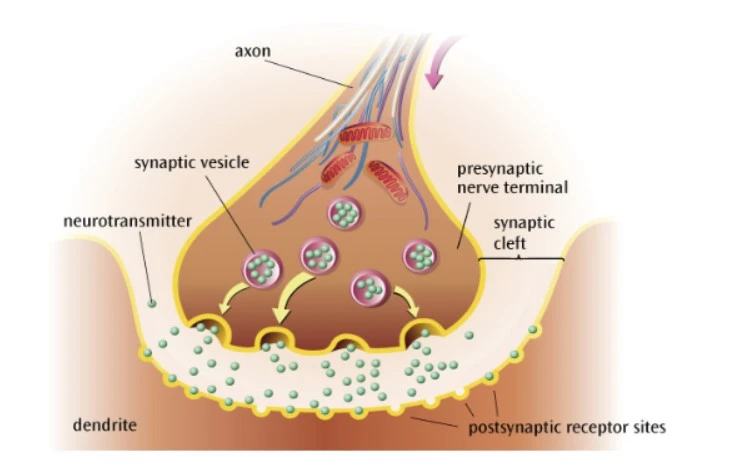
Click on this link to open another YouTube clip describing this process in detail
Exam Question: Outline the structures and processes involved in synaptic transmission. (6)
Information from the environment that is received from our senses trigger an electrical impulse. (1) Electrical impulses (action potentials) reach the presynaptic terminal (1) These electrical impulses (action potentials) trigger release of neurotransmitters such as dopamine (1) These neurotransmitters cross the synapse once they have been released from vesicles (1). The neurotransmitters then combine with receptors on the postsynaptic membrane (1). The stimulation of postsynaptic receptors by neurotransmitters result in either excitation or inhibition of the postsynaptic membrane. (1)
Excitation and Inhibition
To make a working nervous system, only two forces are necessary: excitation and inhibition. Excitatory signaling from one cell to the next makes the latter cell more likely to fire. Inhibitory signalling makes the latter cell less likely to fire.
How are excitation and inhibition involved in synaptic transmission:
- Neurotransmitters can be excitatory or inhibitory
- If the neurotransmitter is excitatory then the post synaptic neuron is more likely to fire an impulse.
- If the neurotransmitter is inhibitory then the post synaptic neuron is less likely to fire an impulse.
- The excitatory and inhibitory influences are summed, if the net effect on the post synaptic neuron is inhibitory, the neuron will be less likely to ‘fire’ and if the net effect is excitatory, the neuron will be more likely to fire.
The balance between neural excitation and neural inhibition is crucial to healthy cognition and behaviour. A brain dominated by excitation would only be capable of exciting itself in repeated bursts of activity, similar to an epileptic seizure. A brain dominated by inhibition would only be capable of quiet whispers of activity, with little synchronization necessary for meaningful communication between brain areas.
